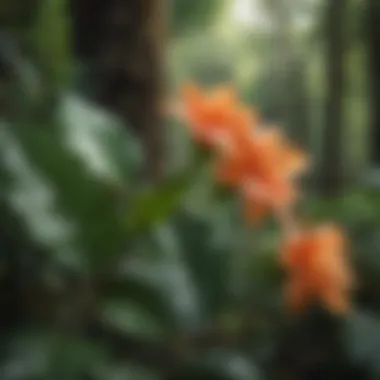Exploring the Sambucas Plant: Insights for Sustainable Woodland Practices


Intro
The Sambucas plant, widely regarded for its unique ecological and medicinal benefits, is garnering attention in the field of sustainable forest management. This plant not only contributes to diverse ecosystems but also presents opportunities for innovative forestry practices. By examining the relevance and applications of Sambucas, this article aims to elucidate its role in enhancing woodland stewardship while addressing contemporary challenges faced by forestry professionals.
Understanding the intricate balance within forest ecosystems is crucial. It involves recognizing how various species, including Sambucas, interact within terrestrial habitats. This article will explore its botanical characteristics, growth conditions, and the wider implications for biodiversity and carbon sequestration. A thorough grasp of these elements can immensely aid forestry professionals and academic researchers.
Now, let’s delve into the wider implications of forestry practices to set the stage for our discussion on Sambucas.
Prologue to the Sambucas Plant
The Sambucas plant holds significance in various ecosystems and plays a crucial role in sustainable forestry management. Focusing on this plant is vital for understanding its contributions to biodiversity and its potential benefits in forestry practices. Ecologically, Sambucas offers numerous advantages. It supports various species, contributing to a balanced ecosystem. Furthermore, its medicinal properties present innovative opportunities for health sectors and can enhance the livelihoods of local communities.
Definition and Overview
Sambucas, commonly known as elderberry, belongs to the Adoxaceae family. This genus includes several species, the most notable being Sambucus nigra. The plant is well recognized for its small black or blue berries and resilient growth habit. It can grow in various environments and is generally characterized by hollow stems and compound leaves. The flowers from the Sambucus plant are also notable, often used to produce syrups or beverages.
Historical Context
Historically, the Sambucas plant has been utilized for centuries. Its origins trace back to ancient civilizations, where it was used for medicinal purposes. Elderflowers and berries have been part of folk medicine in Europe and various cultures. Various traditions hold the plant in high regard, often associating it with protective qualities and remedies against ailments. Through the ages, knowledge about Sambucas has evolved, reflecting changes in agriculture and natural resource management. Today, as sustainable practices gain traction, the historical uses and ecological importance of Sambucas are even more relevant.
Botanical Characteristics
The botanical characteristics of the Sambucas plant are crucial for understanding its role in ecosystems and sustainable forestry practices. These traits influence how the plant interacts with its environment and other species. A detailed examination of the Sambucas plant’s taxonomy, morphology, and reproductive biology provides a foundation for appreciating its ecological significance. This section highlights the aspects that define the Sambucas plant and how they contribute to its resilience and utility in forestry.
Taxonomy and Classification
The Sambucas plant belongs to the family Adoxaceae. Its common name is elderberry, and it has several species, with Sambucus nigra being one of the most recognized. Taxonomically, the classification of Sambucas reveals its relationship within the plant kingdom and the ecological niches it occupies. Understanding its classification helps in identifying its specific environmental preferences and potential uses. The understanding of taxonomy also assists in distinguishing between different species, particularly as they may have varying properties and benefits.
Morphological Features
Morphologically, the Sambucas plant is characterized by its distinctive features. Typically, the plant can grow between 3 to 10 meters tall. It produces opposite, compound leaves that can reach lengths of 30 cm. The leaves provide significant surface area that assists in photosynthesis, making the plant efficient in energy conversion. Sambucas also bears clusters of small white or cream flowers, which bloom in the summer. These flowers are not only aesthetically appealing but also attract various pollinators, enhancing biodiversity in the habitat. The fruit, small dark berries, are another notable feature. These berries contain high levels of antioxidants and have various medicinal uses, making the plant valuable from both ecological and economic perspectives.
Reproductive Biology
The reproductive biology of Sambucas is noteworthy. These plants are primarily self-fertilizing, allowing for effective reproduction even in isolation. Flowering occurs in late spring and continues into summer, resulting in fruiting by late summer or fall. The berries develop a rich nutrient profile, serving as food for numerous wildlife species. This reproductive strategy is essential for sustaining populations, especially in disturbed habitats. The ability to thrive without reliance on other plants for Cross-pollination makes Sambucas adaptable to various environments.
Understanding the botanical characteristics of the Sambucas plant is essential for leveraging its benefits in sustainable forestry and enhancing woodland environments.
Overall, the botanical characteristics of the Sambucas plant provide insights necessary for its effective inclusion in forestry practices. By fostering knowledge in taxonomy, morphology, and reproductive biology, forestry professionals can better integrate this species into ecological management strategies and conservation efforts.
Ecological Significance
The ecological significance of the Sambucas plant cannot be overstated. As a vital component of forest ecosystems, this plant contributes to various ecological functions and supports a range of life forms. Understanding its role enhances our appreciation of biodiversity conservation and sustains forestry practices.
Role in Biodiversity
Sambucas plays a crucial role in maintaining biodiversity within woodland areas. It provides food and habitat for various animals, birds, and insects. The plant's flowers attract pollinators, which are essential for the reproduction of many other plant species. Protecting Sambucas can therefore help maintain the balance of forest ecosystems and promote a diverse array of flora and fauna.


- Food Source: Sambucas berries are consumed by several wildlife species, serving as a nutritious food source.
- Habitat Provision: The dense growth of Sambucas can provide shelter and nesting sites for small mammals and birds.
Habitat Contributions
The contributions of the Sambucas plant to habitat formation are significant. By growing in clusters, it creates microhabitats that sustain various organisms. These habitats are especially important for species that require specific environmental conditions to thrive. The plant's deep roots also help prevent soil erosion, aiding in soil stability and water retention, which is beneficial for other plants in the ecosystem.
Interactions with Other Species
Interacting with other species is another key aspect of Sambucas’s ecological significance. The plant engages in complex relationships with both beneficial and detrimental species.
- Mutualistic Relationships: For instance, Sambucas hosts a variety of pollinators that aid in its reproduction, thereby supporting a larger ecosystem.
- Pest Dynamics: However, Sambucas can also attract pests. Using integrated pest management techniques can help mitigate these challenges without harming beneficial species.
"Sambucas bridges ecological gaps, linking various species and promoting ecosystem function."
In summary, the Sambucas plant is an integral part of forest ecology, influencing biodiversity, habitat structure, and interspecies interactions. Its preservation is crucial for maintaining sustainable forest ecosystems.
Growth Conditions and Cultivation
The growth conditions and cultivation methods of the Sambucas plant are crucial to maximizing its ecological benefits and utility. Understanding the specific needs outlined in this section allows for effective management and conservation strategies, which are essential for promoting sustainable woodland practices. When cultivated correctly, the Sambucas plant can contribute to soil health, biodiversity, and ecosystem resilience.
Optimal Soil Requirements
Sambucas thrives best in well-draining soils rich in organic matter. Ideally, a soil pH between 6.0 and 8.0 balances nutrient availability. Heavy clay or compacted soils hinder root growth and water retention, detracting from plant health. Incorporating compost or well-rotted manure enhances soil structure and fertility, facilitating better growth. The use of soil amendments such as perlite or vermiculite can also improve aeration and drainage.
Maintaining optimal soil moisture is vital. Sambucas plants can tolerate some drought, but they flourish in consistently moist conditions. Therefore, regular monitoring of soil moisture helps inform irrigation practices, especially during dry periods.
"Soil health is critical for biodiversity and sustainable forestry. Healthy soil leads to healthy plants."
Climate Considerations
The Sambucas plant favors temperate climates, with clear seasonal changes. It is adaptive to a range of climatic conditions. However, extreme cold or heat can stress the plant. Ideally, temperatures between 15°C and 25°C promote optimal growth. In regions with harsh winters, protective measures such as mulching can shield the roots, maintaining soil temperature and moisture.
Sunlight plays a significant role in the plant's development. Sambucas prefers full sun or partial shade, although too much shade can lead to weak growth. When planning a cultivation area, selecting a location that receives ample sunlight is essential.
Propagation Techniques
Propagation of the Sambucas plant can be achieved through several methods, each with its own advantages. Seed propagation is the most common approach due to its simplicity and cost-effectiveness. Seeds need to be stratified for about four weeks to enhance germination rates. This mimics natural conditions, as seeds typically experience cold stratification in the wild.
Another effective method is vegetative propagation, which includes stem cuttings or root divisions. Stem cuttings taken from healthy plants can root in water or moist soil. This technique allows for the cloning of superior specimens, preserving desirable traits.
Seed propagation requires patience, while vegetative methods deliver quicker results.
Lastly, tissue culture has emerged as a modern technique, allowing for high bioproductivity and limited space use. This method is suitable for commercial cultivators aiming to produce large quantities of Sambucas in a controlled environment.
Overall, understanding and applying the right growth conditions and cultivation methods can significantly impact the success of Sambucas. By focusing on these elements, forestry professionals can improve ecological outcomes and sustainable practices.
Uses of the Sambucas Plant
The Sambucas plant is renowned for its multifaceted roles in human health, cuisine, and cultural practices. Understanding these uses is crucial for recognizing the plant's importance not only for individuals but also for sustainable woodland practices. This section delves into the medicinal properties, culinary applications, and cultural significance, providing a comprehensive understanding of how Sambucas integrates into our lives.


Medicinal Properties
The Sambucas plant is often praised for its various medicinal benefits. One of the most studied aspects is its ability to bolster the immune system. Research suggests that elderberry extract can help reduce the duration and severity of flu symptoms. Consuming Sambucas products may also aid in fighting inflammation due to its high antioxidant content. This plant contains compounds like flavonoids and phenolic acids, which have been linked to improved health outcomes.
Additionally, the Sambucas plant has diuretic properties that can assist in reducing water retention and flushing toxins from the body. Traditional herbal medicine often points to the use of Sambucas in treating respiratory issues, including colds and bronchitis.
"Sambucas has appeared in various cultures as a home remedy, showcasing its potential across different traditions."
Culinary Applications
Culinary uses of the Sambucas plant are diverse and intriguing. The berries, when cooked properly, can be transformed into jams, jellies, and syrups. These food products offer a rich, tart flavor that enhances desserts and savory dishes alike. Sambucas flowers can also be utilized to create fragrant infusions, pastries, and fritters, providing an aromatic twist to culinary creations.
Beyond its flavor, the nutritional aspects of Sambucas berries are notable too. They are rich in vitamins A, C, and antioxidants, contributing to a balanced diet. These features make Sambucas a desirable ingredient for health-conscious consumers looking for natural methods to enhance their meals.
Cultural Significance
Culturally, the Sambucas plant holds a remarkable place across various traditions. In many societies, it is seen as a symbol of protection and healing. Its folklore is rich, with tales often reflecting its vibrant role in community health rituals and celebrations.
In some cultures, Sambucas flowers are associated with fertility and renewal, making them a popular theme in spring festivals. Recognizing such cultural ties underscores the importance of preserving the Sambucas plant in sustainable forestry practices. By championing its uses, communities can promote biodiversity and maintain cultural heritage, fostering a respectful relationship with nature.
In summary, the uses of the Sambucas plant are integral not only for human benefit but also for maintaining ecological and cultural balance. Understanding these dimensions informs sustainable practices that respect both the plant and the environments in which it thrives.
Sambucas in Sustainable Forestry
The inclusion of Sambucas in sustainable forestry practices presents a multi-faceted approach toward ecological balance and economic viability. This plant is not just a species of interest in terms of medicinal and culinary uses; it is an integral component of the forest ecosystem that contributes significantly to sustainability efforts. Understanding its role can aid in optimizing woodland management and promoting biodiversity.
Importance for Ecosystem Services
Sambucas provides numerous benefits through its various ecosystem services. Firstly, it offers habitat for a diverse range of species, thus contributing to overall biodiversity. When integrated into forestry systems, it enhances wildlife corridors, ensuring species can navigate their environment more easily. Additionally, Sambucas plays a crucial role in nutrient cycling within the soil, which is vital for plant health and forest productivity.
The provisioning services offered by Sambucas include resources like fruits and flowers, beneficial not only for local fauna but also for human consumption. The regulating services, such as flood mitigation and air quality improvement, enhance the resilience of forests against climate extremes. This plant supports these vital processes, underscoring its critical place in sustainable forestry management.
Carbon Sequestration Potential
The carbon sequestration capacity of Sambucas is an essential aspect of climate change mitigation strategies. As a growing plant, it absorbs carbon dioxide from the atmosphere, storing carbon in its biomass and the surrounding soil. This characteristic makes it a valuable ally in efforts to reduce greenhouse gases.
In research studies, it has been demonstrated that plants like Sambucas can enhance soil organic carbon content significantly. By improving overall soil structure and health, the plant aids in locking carbon and preventing its release back into the atmosphere. Thus, integrating Sambucas into forestry practices can align with global objectives aimed at combating climate change.
Enhancing Soil Health
Soil health is a crucial component of sustainable forestry, and Sambucas contributes positively in this area. By establishing a robust root system, this plant helps improve soil structure and aeration. The root biomass increases the soil's organic matter content, which in turn influences water retention and nutrient availability.
Furthermore, Sambucas can aid in the prevention of soil erosion through its ground cover, especially during periods of heavy rainfall. This protective feature is critical for maintaining soil fertility and securing the local ecosystem's integrity. Its ability to foster beneficial soil microorganisms can also enhance nutrient cycling, resulting in a healthier ecosystem overall.
“Sambucas plays a critical role in enhancing the sustainability of woodland management through its myriad contributions.”
Challenges in Cultivating Sambucas


The successful cultivation of the Sambucas plant involves addressing several significant challenges. Understanding these complexities is crucial for forestry professionals aiming to promote sustainable woodland practices. To optimize the benefits of Sambucas, we should consider pest management and environmental stress factors that can significantly impact its growth and viability.
Pest and Disease Management
Pest and disease management is a pressing concern for those cultivating Sambucas. Various pests, such as aphids or caterpillars, can damage the leaves and fruit of the plant. Moreover, diseases like powdery mildew can disrupt plant health and reduce yields. Effective management practices are essential. Implementing integrated pest management (IPM) strategies can help mitigate these risks. IPM combines biological control, habitat manipulation, and chemical management only when necessary. Regular monitoring for signs of infestation is also crucial. Early detection can lead to more effective interventions, potentially saving both time and resources.
Additionally, the use of resistant Sambucas varieties may also prove beneficial. Developing and using cultivars that can withstand specific pests can foster a more resilient cultivation environment. Creating biodiversity within the planting sites can reduce pest populations naturally, thus lowering the reliance on chemical pesticides.
Environmental Stress Factors
Environmental stress factors pose another considerable challenge in cultivating the Sambucas plant. Conditions such as extreme temperatures, drought, and soil fertility affect plant health and growth. Understanding these factors can aid in developing strategies to mitigate their impact.
For instance, drought stress can lead to wilting and reduced berry production. It is important for cultivators to select appropriate watering techniques. Employing drip irrigation systems can optimize water use and minimize wastage.
Soil health is equally vital as it directly influences the plant's nutrient uptake. Regular soil tests can provide insights into fertility levels, allowing for tailored amendments.
In summary, effectively overcoming the challenges associated with cultivating Sambucas involves a multi-faceted approach. By managing pests and diseases and addressing environmental stressors, practitioners can significantly enhance the plant's viability and contribution to sustainable woodland practices.
Understanding the challenges in cultivating Sambucas is vital for effective holistic land stewardship.
Future Research Directions
Future research on the Sambucas plant holds significant implications for sustainable woodland practices and broader ecological frameworks. A clear understanding and exploration of this plant can provide insights into its biodiversity contributions, stress resilience, and potential applications in agroforestry.
It is essential to investigate biotechnological approaches that harness the genetic and biochemical properties of Sambucas. These methods may enhance its growth rates, resistance to diseases, and adaptability to changing climates. As the global environment faces increasing pressures, the resilience capacity of plant species becomes more crucial. Research could focus not only on traditional cultivation but also on integrating modern technology to achieve sustainable outcomes.
This approach will benefit not just scientists but also forestry professionals, policymakers, and local communities who depend on woodland resources. By fostering a synergy between technology and traditional ecological knowledge, stakeholders can develop more effective management strategies for the refuse and health of forest ecosystems. Additionally, studying the conservation strategies for Sambucas is vital. The pressures of urban expansion, climate change, and habitat loss necessitate immediate action to preserve the plant's genetic diversity and its role in ecosystems.
Relevant conservation strategies would involve establishing protected areas, promoting community-based conservation efforts, and encouraging partnerships among various stakeholders. Collaboration between local communities and researchers can lead to innovative solutions that honor traditional practices while implementing scientifically-backed methods.
By exploring these avenues, future research can enhance our understanding of the Sambucas plant, positioning it as a valuable component in sustainable forestry initiatives. This knowledge might also lead to broader environmental benefits, including improved biodiversity, better soil carbon management, and enhanced ecosystem services.
"Investing in research on the Sambucas plant is not just about preserving a species; it is about securing the future of our forest ecosystems and the myriad life forms they support."
Ending
The conclusion serves as a crucial element in this article, summarizing the vital insights related to the Sambucas plant and its significance in sustainable woodland practices. It underscores the multifaceted benefits this plant offers, from enhancing biodiversity to contributing to carbon sequestration and improving soil health. By recognizing these aspects, we can better appreciate its role in forest ecosystems and the importance of integrating it into contemporary forestry management.
In summarizing the discourse on the Sambucas plant, we highlight several key points:
- Its medicinal and culinary applications.
- The ecological services it provides, including habitat support.
- The significance of sustainable practices in forestry management.
The final thoughts emphasize that sustainable forestry cannot be achieved in isolation; it requires a holistic approach that integrates the knowledge and practices pertaining to the Sambucas plant. This plant is not merely a species of interest; it presents numerous opportunities for enhancing woodland stewardship.
Summary of Key Points
- Biodiversity: Sambucas plants support diverse wildlife, playing a significant role in maintaining ecological balance.
- Carbon Sequestration: These plants have a potential for capturing carbon, contributing to climate change mitigation.
- Soil Health: The root system and decaying leaves improve soil quality, supporting other plant species and crop production.
- Medicinal Uses: Rich in nutrients, Sambucas holds potential for pharmaceutical applications.
- Culinary Significance: It provides essential ingredients and flavors in various cuisines.
Call for Action in Forestry Practices
To effectively integrate this knowledge into sustainable forestry practices, it is essential for professionals and stakeholders to advocate for and implement the following strategies:
- Promote Research: Support initiatives that study the ecological impacts of the Sambucas plant in various environments.
- Sustainable Cultivation: Encourage methods that allow for the sustainable harvesting of Sambucas while maintaining its native populations.
- Public Education: Facilitate workshops and seminars to educate communities on the importance of Sambucas in ecosystems.
- Policy Development: Collaborate with governmental and non-governmental organizations to develop policies that protect and enhance the habitats for Sambucas.
By mobilizing toward these actions, forestry professionals can greatly contribute to the implementation of sustainable practices that benefit both the ecosystem and human health.















